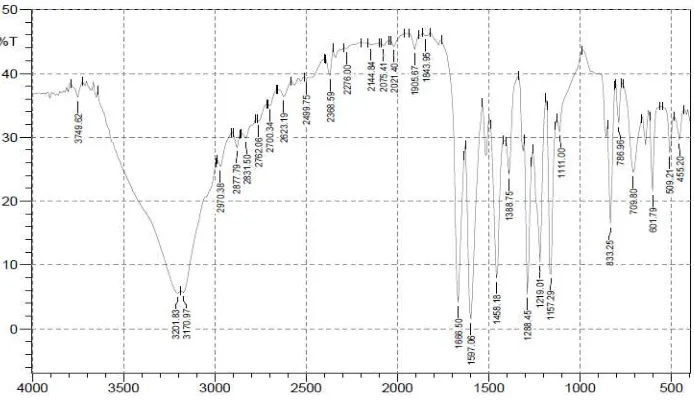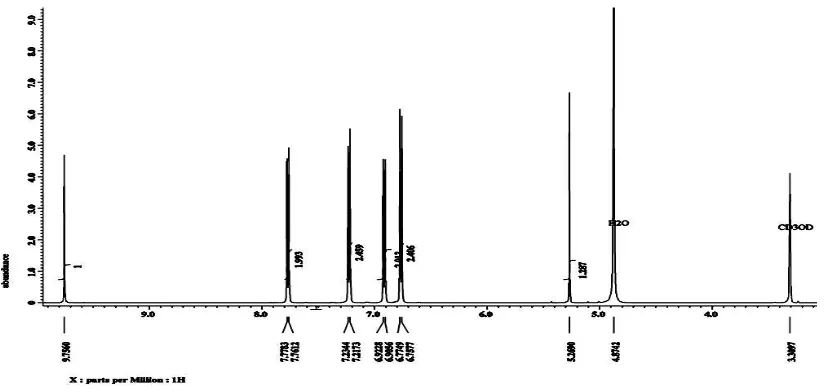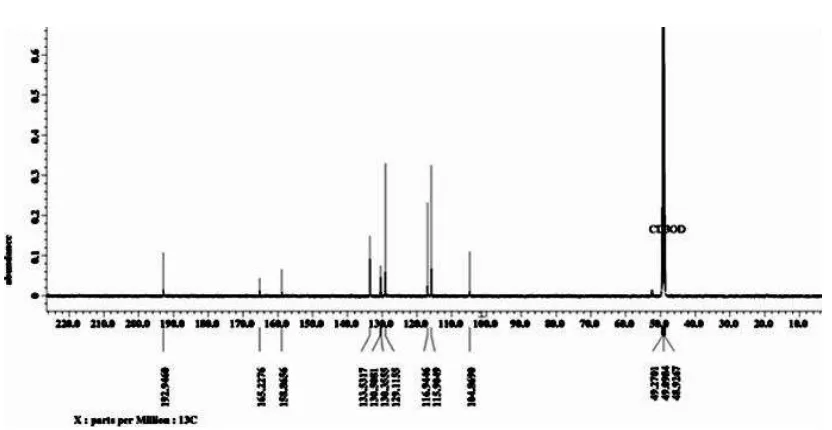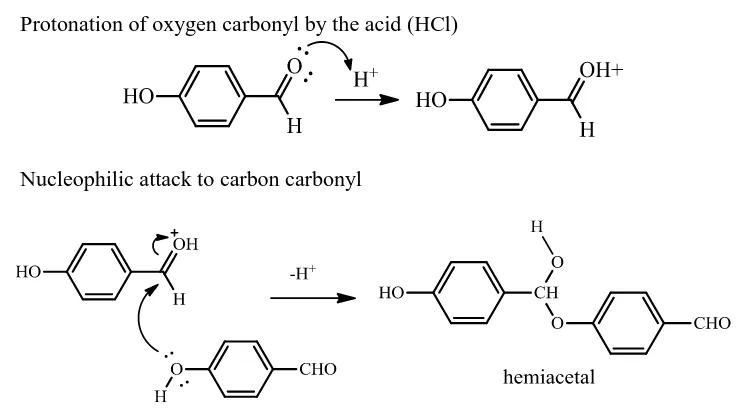C-24
STUDY OF ACID CATALYSIS FOR CONDENSATIONOF
4-HYDROXYBENZALDEHYDE WITH ACETONE
Sri Handayani
Chemistry Education, Faculty of Mathematics and Science, Yogyakarta State University
Abstract
In previous research, condensation reaction between 4-hydroxybenzaldehyde and acetone has been done with mol ratio 2:1 using hydrochloric acid as catalyst. Structure elucidation was conducted using FTIRspectrophotometer, 1D and 2DNMR proofed that the compound of 4-(hydroxy(4-hydroxyphenyl)methoxy)benzaldehyde was produced instead of 4,4′ -dihydroxydibenzalacetone. It was predicted that intermolecular reaction of 4-hydroxybenzaldehyde compound through acid catalyzed hemiacetal formation involved within the mechanism.
Key words: 4-hydroxybenzaldehyde, hemiacetal, acid catalyst
INTRODUCTION
Introduction
Aldol condensation is intermolecular nucleopilic adition from enolate ion to carbonyl
group, resulting β-hydroxy aldehyde. Condensation between aldehyde or acetone with carbonyl
groups from different aldehyde or ketone was called as cross aldol condensation. Condensation reaction of aldehyde that has no Hα can be occurred as other aldehyde preserve Hα while as in its form the dimerization is not possible. A cross aldol condensation will be very useful if there is only one carbonyl compound with Hα, thus the reaction would not result mixed reaction product.
According to mechanism of the reaction, aldol condensation is classified in two reaction mechanism types namely enol and enolate mechanism. Enol mechanism occurs in an acidic condition, while the enolate is in a basic condition. Sodium hydroxide as basic catalyzed cross aldol condensation between benzaldehyde derivatives and acetone has been investigated to produce benzalacetone and its derivatives(Handayani & Arty, 2008).Synthesis of two hydroxydibenzalacetones with base catalyst through crossed aldol condensation also reported by Handayani, et al., (2010). Acid catalyst that often to be used in aldol condensation reaction is sulphuric and hydrochloric acid.
Benzalacetone, as a product of crossed aldol condensation still contained Hα in high level acidity make it is easyly to be break and become a new nucleophile. The new nucleophile from benzalacetone derivative could attacks other carbonyl through aldol condensation chain reaction to produce dibenzalacetone derivatives. Thus, double crossed aldol condensation reaction beetwen acetone and benzaldehyde in 1: 2 mol ratio will produce dibenzalacetone.
acidic condition, cyclopentanone will forms enol structure and acts as nucleophile that could attacks benzaldehyde derivatives in condensation reaction.
Crossed aldol condensation between acetone and 2-hydroxybenzaldehyde in 1:2 mol
ratio produce 2,2′-dihydroxydibenzalacetone in base catalyst, while acetone and
3-hydroxybenzaldehyde in the same mole ratio give 3,3′-dihydroxydibenzalacetone (Handayani et
al., 2010). Theoretically, as acetone and 4-hydroxybenzaldehyde are reacted in the same mole ratio will give 4,4′-dihydroxydibenzalacetone as product. On the contrary, in present research, aldol condensation between acetone and 4-hydroxybenzalacetone in 1:2 mol ratio under acid catalyst had produced a new compound instead of 4,4′-dihydroxydibenzalacetone as dibenzalacetone derivative(Handayani, 2012).
The aim of this article is to study the reaction mechanism between 4-hydroxybenzaldehyde and acetone using hydrochloric acid as catalyst that give a new compound. 4-hydroxybenzaldehyde has carbonyl and hydroxyl group, where as acetone has carbonyl group and Hα. Based on the existence of nature groups there are four possible reaction that could be happen, namely aldol condensation, crossed aldol condensation, hemiacetal or hemiketal formation.
DISCUSSION
d, J=8.6 Hz, H3b and H5b), 6.9 (2H, d, J=8.6 Hz, H3a and H5a), 7.2 (2H, d, J=8.6 Hz, H2b and H6b), 7.7 (2H, d, J=8.6 Hz, H2a and H6a), 9.7 (1H, s, H1) ppm; 13C NMR (CD
3OD): δ = 104,
115, 116.9, 129, 133.5, 158.9, 165, 130.5, 130.3, 192 ppm (Handayani, 2012).
Identification of functional groups by using an infrared spectrophotometer showed the appearance of absorption at wave numbers of 3201.83 cm-1 of the OH bond, which is
conjugated with the phenyl carbonyl at 1666.5 cm-1, C=C aromatic at 1597.06 and 1458.1 cm-1
and COC bonds in 1111 - 1268.45 cm-1. The IR spectra show the characteristic absorptions of
the hydroxyl group at the position of the target compound cross aldol condensation reaction proceeds, but the characteristic peak of aldehyde also still exist in the region 2877 and 2870 cm -1(Pavia et al., 2009).
Characterization number, position and kind of proton and carbon was done using spectropotometer NMR as showed in Fig. 2 and 3 and the data listed in Table 1. Thesinglet peak at 5.27 ppm regions connected to C at 104 ppm, and adjacent with C at 129 ppm. This peak is appeared in a farther upfield area compared to all other protons. The proton shift shows that it is attached to the aliphatic C (H-C). The other singlet peak appeared at the downfield area(9.7 ppm), connected to C at 192 ppm is a typical of the aldehyde group. These protons adjacent to C at 133.5 and 130.3 ppm of aromatic carbon. It is estimated that this proton is came from aldehyde group (CHO) attached to the aromatic ring.
In addition to the two singlet peaks, 4 peaks are doublets with coupling constants J are 8.6 Hz which indicates the aromatic protons. Integration of each doublet peak indicates that each peak has 2 equivalent protons, it is estimated that the synthesized compounds have two aromatic rings. HMBC spectra showed that the protons next to the aldehyde group is the peak at 7.7 ppm. Two proton peaks at 6.7 and 7.2 ppm adjacent to C 158 ppm indicating that the aromatic protons adjacent to the C-OH.
Fig 3. 13C NMR spectra of the product synthesis (CD 3OD)
Table 1. NMR (1H and 13C) data of the product synthesis (CD 3OD)
No C δH ppm ∑H, m, J (Hz) δC ppm HMBC (HC)
1 9.7 - 192 C1a, C2a, C6a
1a - - 130.3 -
2a, 6a 7.7 2, d, 8.6 133.5 C2a, C6a, C4a, C1
3a, 5a 6.9 2, d, 8.6 116.9 C1a, C3a, C5a
4a - - 165 -
2 5.27 1, s 104 C2b, C6b
1b - - 130.5 -
2b, 6b 7.2 2, d, 8.6 129 C2, C2b, C6b, C1b
3b, 5b 6.7 2, d, 8.6 115 C4b, C3b, C5b, C1b
4b - - 159 -
Targetted structure of compound synthesis is presented in Fig. 4a while the estimated structure with HMBC correlations of new compound synthesized is presented in Fig 4b.1H and 13C NMR. Comparison between new compound synthesized and ChemDraw prediction are
presented in Table 2.The data shows the similarity of chemical shift of compound synthesized.Based on these data it is concluded that the new compound synthesized is 4-(hydroxy(4-hydroxyphenyl)methoxy)benzaldehyde.
Synthesis of 4,4'-dihydroxydibenzalacetone is usually performed under acidic conditions. Acid catalyst was used to prevent proton abstraction of the hydroxy group by base catalyst. Hydroxy proton on the phenolic compound is more acidic than alcohol Ka=10-10-10-8)
so easily dislodged by the presence of a base(Bruice, 2007). However, the use of acid catalyst did not give the expected result. The result provided that acetone and 4-hydroxybenzaldehyde
did not give the target compound, i.e. 4,4′-dihydroxydibenzalacetone. Structure elucidation with
FTIR and NMR 1D and 2D prove a new hemiacetal compound, i.e. 4-(hydroxy(4-hydroxyphenyl)methoxy)benzaldehyde. Unexpected hemiacetal formation has also been reported in the acetylation reaction of sterical hindered alcohols with vinyl acetate using lipase as catalyst (Högberg et al., 2000).
Table 2. 1H and 13C NMR Comparison between synthesized compound and ChemDraw prediction
According to structure elucidation data, the resulting material was formed through hemiacetal formation reaction. Hemiacetal is a product that resulted from alcohol addition to an aldehyde with the presence of acid catalyst (Bruice, 2007). In this research, acetone was reacted with 4-hydroxybenzaldehyde–an aldehyde that have hydroxyl group–in acidic condition. Therefore, 4-hydroxybenzaldehyde could be acted as aldehyde or alcohol in hemiacetal formation. Acid catalyst played an important role to lead the reaction by protonating oxygen carbonyl so it more responsive to nucleophil attacks. Reaction of hemiacetal formation occurs between C carbonyl of 4-hydroxybenzaldehyde and OH group of other 4-hydroxybenzaldehyde as the nucleophil.
2. Nucleophilic attack to carbon carbonyl
Cross aldol condensation between 4-hydroxybenzaldehyde and cyclopentanone using sulphuric acid catalyst has been reported by Pudjono et al. (2008). Reaction mechanism was through enol mechanism with cyclopentanone acted as the enol. Reaction was performed at reflux temperature with solvent of 2-butanol. Heat treatment was aimed to increase the reagent solubility which was expected to increase the number of collided particle, thus resulting higher yield and more effective reaction. This research have been performed at different reaction temperature and catalyst, which done at 100C with catalyst of hydrochloride acid. Acid strength
of acid catalyst is different each other. It predicted that hydrochloride acid less able to protonate oxygen carbonyl of acetone to form enol. Acetone could undergoes tautomerisation keto and enol. Acetone tautomere in keto form more stable than enol form, because acetone energy is smaller than propen-2-ol (Figure 5). It means that acetone required less energy to reach equilibrium propen-2-ol. This condition caused acetone in enol form could not act as nucleophile in cross aldol condensation. Therefore, H acid was likely to protonate oxygen carbonyl 4-hidroxyibenzaldehyde leading to induction effect followed by hydroxyl group attack of other 4-hidroxysibenzaldehyde to form a hemiacetal.
Fig 5. Tautomer keto-enol of acetone
Fig 6. Resonance effect of 4-hydroxybenzaldehyde on oxygen carbonyl basicity
Fig 7. Intra and intermolecular hydrogen bond of ortho and para hydroxybenzaldehyde
Fig8. Resonance effect of 3-hydroxybenzaldehyde on oxygen carbonyl basicity
Cross aldol condensation between 2-hydroxybenzaldehyde or 3-hydroxybenzaldehyde and acetone to form 2,2′-dihydroxybenzalacetone (IUPAC name:(1E,4E)-1,5-bis(2-hydroxyphenyl)penta-1,4-dien-3-one) and3,3′-dihydroxybenzalacetone (IUPAC name: (1E,4E)-1,5-bis(3-hydroxyphenyl)penta-1,4-dien-3-one) using base catalyst at 100C had been reported
(Handayani et al., 2010). Both reactions are easier occur because 2-hydroxybenzaldehyde (ortho) could form intramolecular hydrogen bonding (Figure 7) so it reduces intermolecular attraction compared 3-hydroxybenzaldehyde (meta) or 4-hydroxybenzaldehyde (para). Therefore hydroxyl group at ortho or meta position of benzaldehyde was less reactive compared to hydroxyl group at para position and the hydroxyl group would not interfere the aldol condensation reaction. The resonance of 3-hydroxybenzaldehyde that having hydroxyl group at meta position was showed at Figure 10, which indicated that resonance effect of 3- hydroxybenzaldehyde does not influence the basicity of oxygen carbonyl. Based on the explanation above, it can be concluded that hydroxyl group at ortho and meta position does not influence to aldol condensation reaction.
CONCLUSION
Condensation reaction between 4-hydroxybenzaldehyde and acetone (mol ratio 2:1)
using hydrochloride acid catalyst does not give the expected compound (i.e. 4,4′
Bruice P Y. (2007). Organic Chemistry (Fifth edit.). USA: Pearson Prentice Hall.
Handayani, S. (2012). Synthesis of Benzalacetone Analogue Over NaOH-/ZrO2-montmorillonite as Catalyst and Its Antioxidant Activity Test. Gadjah Mada University.
Handayani, S., & Arty, I. S. (2008). Synthesis of Hydroxyl Radical Scavengers from Benzalacetone and its Derivatives, 19(2), 61–68.
Handayani, S., Matsjeh, S., Anwar, C. and Atun, S. (2010). Synthesis and activity test as antioxidant of two hydroxydibenzalacetones. In PACCON2010 (pp. 686–688). Ubon Rachatani, Thailand.
Högberg, H.-E., Lindmark, M., Isaksson, D., Sjödin, K., Franssen, M. C. R., Jongejan, H., … de Groot, A. (2000). Formation of hemiacetal esters in lipase-catalysed reactions of vinyl esters with hindered secondary alcohols. Tetrahedron Letters, 41(17), 3193–3196. doi:10.1016/S0040-4039(00)00328-2
Pavia Donald L., Lampman Gary M, Kriz George S, V. J. R. (2009). Introduction to Spectroscopy (fourth edi.). Washington: Brooks/Cole.
Pudjono, Sismindari and Widada, H. (2008). Synthesis of 2,5-bis-(4’ -hydroxybenzylidene)cyclopentanone and 2,5-bis(4’-chlorobenzylidene) cyclopentanone compounds and Antiproliferative Test to Hela Cells. Majalah Farmasi Indonesia, 19(1), 48–55.




